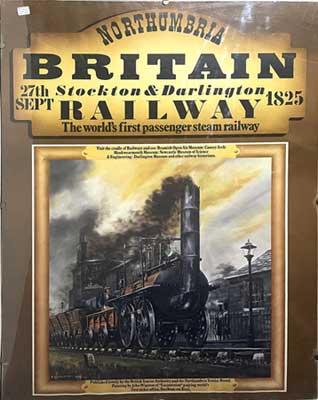
Original 150th. year commemoration poster
Northumbria /Britain/ Stockton and Darlington Railway/ 27th of September 1825/ The world’s first passenger steam railway
Visit the cradle of railways and see: Beamish Open Air Museum: Causey Arch: Monkwearmouth Museum: Newcastle Museum of Science & Engineering: Darlington Museum and other railway historiana.
Published jointly by the British Tourist Authority and the Northumbria Tourist Board
Painting by John Wigston [1974] of “Locomotion” passing world’s
first ticket office, Stockton-on-Tees.
Offset lithograph 39 x 28” (99 x 71.1 cm) supported by acid free board under plexiglass.
Ref. JC1(201)/GN/l.anaa>DEL PRICE CODE A
The Stockton and Darlington Railway (S&DR) was a railway company that operated in north-east England from 1825 to 1863. The world's first public railway to use steam locomotives. While coal 'waggons' were hauled by steam locomotives from the start, passengers were carried in coaches drawn by horses until carriages hauled by steam locomotives were introduced in 1833. The Act that received royal assent on 19 April 1821 allowed for a railway that could be used by anyone with suitably built vehicles on payment of a toll, that was closed at night. On 27 September, 12 ‘waggons’ of coal were attached to engine Locomotion No. 1, and coach Experiment, plus 21 new coal ‘waggons’ fitted with seats. The directors had allowed room for 300 passengers, but the train left carrying between 450 and 600 people.
The ‘Quaker’ line eventually became highly successful. This new railway initiated the construction of more railway lines, causing significant developments in railway mapping and cartography, iron and steel manufacturing, as well as in any industries requiring more efficient transportation.


